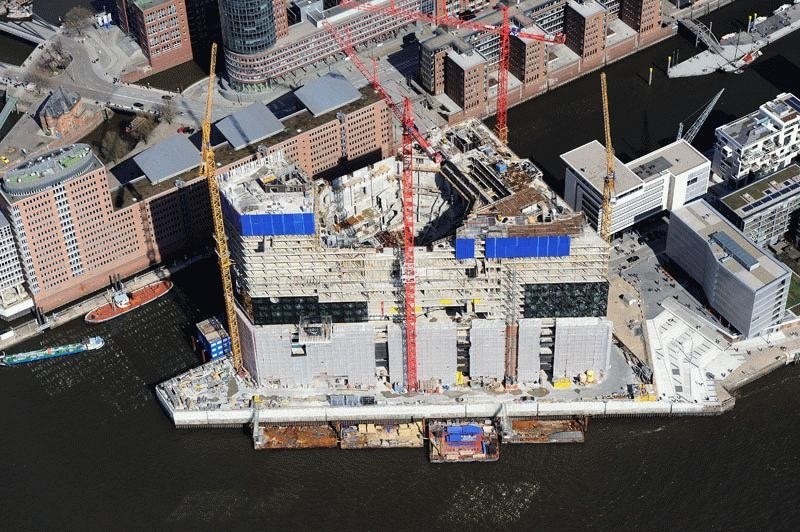The Elbphilharmonie, Hamburg’s stunning new concert hall designed by the Swiss architectural team Herzog & de Meuron, has been presented this morning at an official topping-out ceremony accompanied by a weekend of celebrations.
Hamburg is building a cultural landmark: The Elbphilharmonie Hamburg. In the
middle of the flow of the river Elbe on approx. 1.700 reinforced concrete piles a
building complex is emerging, which, in addition to three concert halls, will
encompass a hotel, 45 apartments and the publicly accessible Plaza with a 360°
panoramic view of the city. The centerpiece of the Elbphilharmonie is also one of
the most exciting construction challenges in Europe at the moment: A world-class
concert hall at a height of 50 meters with seating for 2.150, which for soundproofing
reasons is de-coupled from the rest of the building.
Herzog & de Meuron
Project Description Elbphilharmonie Hamburg
A New Location in the City - The City in a New Place
The Elbphilharmonie on the Kaispeicher marks a location that most people in
Hamburg know about but have never really noticed. In the future it will become a
new center of social, cultural, and daily life for the people of Hamburg as well as
visitors from all over the world.
The Kaispeicher A, designed by Werner Kallmorgen and constructed between 1963
and 1966, was originally used as a warehouse for cocoa beans until close to the end
of the last century. The new building has been extruded from the shape of the
Kaispeicher, it is perfectly congruent with the brick block of the older building on
top of which it has been placed. The top and bottom of the new structure are,
however, entirely different from the quiet and plain shape of the warehouse below.
The broad, undulating sweep of the roof rises to a total height of 110 m at the
Kaispitze (the tip of the peninsula), sloping down to the eastern end, where the roof
is some 30 m lower. Correspondingly the bottom of the new superstructure has an
expressive dynamic. Specific zones are defined by either wide, shallow or steep
vaults.
In contrast to the stoic brick façade of the Kaispeicher, the new building above has a
glass façade, consisting in part of curved panels, some of them cut open. The glass
façade transforms the new building into a gigantic, iridescent crystal whose
textured appearance changes as it catches the reflections of the sky, the water and
the city.
The main entrance to the building lies to the east. The elongated escalator curves
slightly as it leads to the top of the Kaispeicher, so that it cannot be seen in full from
one end to the other. The escalator offers its users a surprising spatial experience
through the entire Kaispeicher, past a large panoramic window.
Upon reaching the top of the Kaispeicher, visitors find a unique open space, a new
public Plaza above the city. Sitting on top of the Kaispeicher and under the new
building, it is like a gigantic joint between old and new.
This, too, is a new public space that offers unique panoramic views. Along its edges,
vault-shaped openings create spectacular, theatrical views of both the River Elbe
and the City of Hamburg. Further inside, a deep vertical opening provides constant
spectacular visual relations between the Plaza and the cavernous foyer of the
Philharmonic Hall above. Restaurant, bar, café, and the hotel lobby are located here,
as well as access to the lobby of the new concert halls.
The design for the new Elbphilharmonie is a project of the 21st century that would
have been inconceivable before. The principle design idea of the Philharmonic Hall
as a space where orchestra and conductor are located in the center of the audience,
is a well known typology.
It is also not uncommon that the architecture is composed of an arrangement of tiers
that take their cue from the logic of the acoustic and visual perception. But here this
logic leads to another conclusion. The tiers are more pervasive; tiers, walls, and
ceiling form a spatial unity. This space, rising vertically almost like a tent, is not
determined by the architecture alone but by the 2.150 listeners and musicians who
congregate in order to make and listen to music. The towering shape of the hall
defines the static structure of the entire volume of the building. And is
correspondingly reflected in the silhouette of the building as a whole.
The Elbphilharmonie will become a landmark visible from afar, lending an entirely
new accent to the horizontally conceived city of Hamburg – as an expression of
reaching out into new territory, into the harbor area along the shores of the River
Elbe.
Elbphilharmonie Hamburg by Herzog & de Meuron

View Article details
- Giulia Guzzini
- 28 May 2010